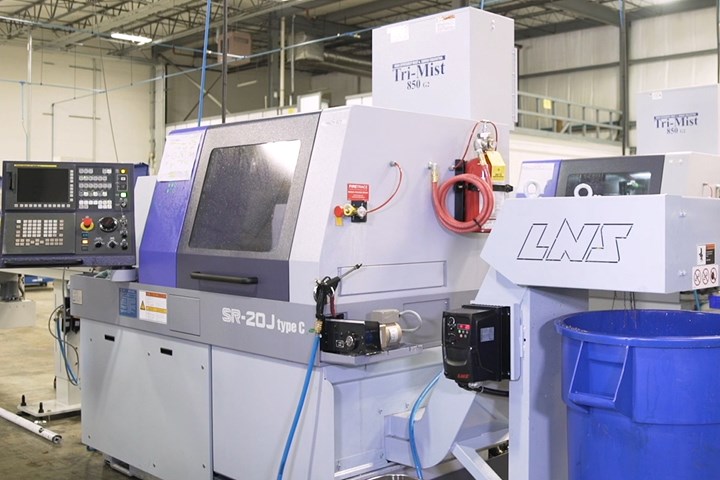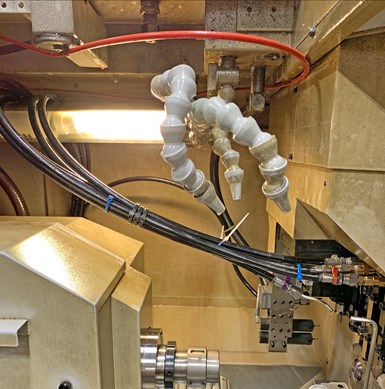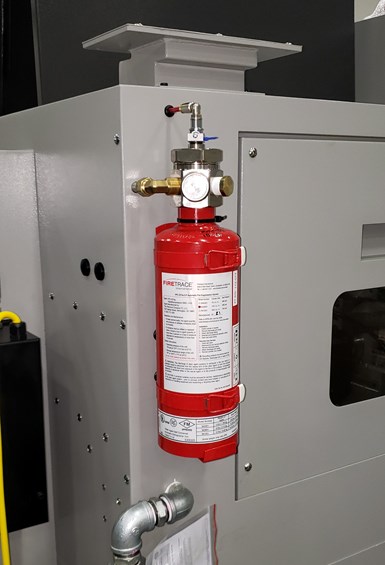System Offers Fast, Catastrophe-Free Fire Suppression
This fire suppression system supplies a chemical agent directly to a fire within a machine tool, helping extinguish it in less than 10 seconds, leaving no machine damage.
Fires do not discriminate. They can happen any time, during any shift, whether a machine tool is attended by an operator or not. And if they are not suppressed immediately, the effects can be devastating to not only your machine tool itself but to your entire facility.
By detecting a fire at its source inside a machine and automatically suppressing it, this company’s system is a simple, quick and clean approach to prevent machine tool catastrophes. In fact, because the suppression equipment works fast, the manufacturer says there is usually minimal to no damage to a machine tool after the system is deployed.
This fire suppression design by Firetrace International can spare machine shops – that utilize the system on all its machine tools – millions of dollars in fire damage. It is also said to minimize machine downtime while preserving customer contracts and employee retention. According to the company, its systems detect, extinguish and save five machine tools per week on average, which translates to rescuing about 260 machine shops per year.
Detect, Activate, Suppress
Instead of employing electronic fire extinguishers to extinguish a fire, this Firetrace system uses specially designed detection tubing (which can be installed and routed anywhere within a machine tool where a fire could start) to not only suppress the fire but detect heat or flames first. This tubing, which is made of a flexible polymer, bursts open upon detection of either element, activating what the company calls its indirect release system (recommended for machine tools).
When the detection tubing bursts, it results in the loss of all nitrogen pressure in the tubing. This activates the indirect valve, enabling the escape of all the Novec 1230 fire-suppression agent from the cylinder. The suppressant travels through the distribution line, through the nozzle and into the machine’s enclosed workzone.
When the fire suppression system is activated, it discharges a chemical clean agent that is stored in the cylinder attached to the outside of the machine tool. Photo Credits: Firetrace International
Inside the cylinder, this agent is in liquid form. But once the system is activated, the cylinders are pressurized and the agent is distributed through the diffuser nozzles in a gas form. This gas suppresses the fire by eliminating the heat.
Because the chemical removes heat instead of oxygen, it is safer to use in occupied spaces than an extinguisher. Therefore, it does not pose a suffocation risk for people, according to the company.
Jeff Gagnon, vice president of sales, Custom Service Solutions (CSS), a distributor of Firetrace for machine tools, explains the short amount of time the suppression process takes. “The system that CSS installs will detect a fire, extinguish the fire, E-stop the machine and mist collector, and provide notification via the audible/strobe alarm within 10 seconds or less.” He adds that the machine is left fire-free and damage-free.
Once the red tubing running along the top of this machine tool detects fire or heat, it ruptures, resulting in the loss of all pressure and causing the indirect valve to activate.
Although the system does not require manual operation, someone can pull and remove the yellow tag from the cylinder, and then push the red button to manually activate the system.
Installation
The fire suppression system can be retrofitted onto any CNC machine tool, regardless of the machine’s age. However, most customers purchasing new machines install Firetrace before they begin making parts. Gagnon says about 40% of his existing customer base since 2007 has retrofitted the system, and almost all his new customers are doing so. Of those customers, he says about 65% are retrofitting the system onto CNC Swiss-type machines.
But whether an installation is new or retrofitted, the company starts the install by understanding customer needs, says Chris Steeples, sales director at Firetrace. He explains that the company asks a lot of questions of the machine shop to customize the system, including what kind of metal is being cut, which cutting oil is being used, what size the machine is, what the cubic size of the machine’s workzone is, and so on.
A typical installation takes three to four hours and is completed by a Firetrace trained technician who is knowledgeable about the mechanics of the machine tool on which the system is being installed. This is critical to understanding where to place the tubing through the interior of the machine so it does not get in the way of the key components within the workzone(s). However, the detection tubing should cross over the mist collector opening in case flames are pulled up through the collector.
The cylinder that contains the Novec 1230 which is attached to the tubing is also strategically placed so it is out of the way of aisle traffic. Therefore, in most cases, it is installed on the back or side of the machine.
“Most importantly, the system must be properly installed by an authorized Firetrace distributor and must be wired into the machine’s E-Stop circuit,” Gagnon stresses. “If not, then only a partial installation has taken place, and the system will not E-Stop the machine and mist collector.”
In the case of Custom Service Solutions providing the service on a machine that has experienced a fire, the company’s technicians travel with full cylinders at all times. The company recommends that machine shops consider having at least one spare cylinder on site.
Setting up the system so that it automatically shuts down and an alarm is sounded when a fire is detected is a standard part of the installation process. The suppression system plugs into the machine tool’s E-stop electrical circuit. This wire is connected to a pressure switch inside Firetrace’s control box. As soon as the pressure switch detects a loss of pressure, it sends an electrical signal through that cable to the stop and break the circuit. This shuts down the machine and the mist collector.
“Shutting down the machine is as important if not more important than putting out the fire initially, because even if you put out the first fire, if the machine continues to run, the root of what caused the fire could continue to generate a second fire,” Gagnon explains. “And then your suppressant agent is gone.”
Another small wire is connected to the alarm, which runs off the same pressure switch, he adds. As soon as there is a loss of pressure in the Firetrace detection tubing, the signal turns on the alarm. The alarm goes off and won't stop, thereby providing notification to machine shop personnel.
Cleanup
According to Steeples, cleaning up after a fire is very easy. He says Novec 1230, which is the brand name for the chemical compound FK-5-1-12 manufactured by 3M, will not contaminate cutting oil or any of the metal to which it comes in contact. After the chemical puts out a fire, it evaporates immediately, eliminating the need for cleanup.
And, because the system is activated as soon as it detects heat and suppresses at the location of the heat, fires do not have the opportunity to spread and cause damage. If there is any damage at all, it is minimal.
“In nearly every case, there is no machine damage,” Gagnon explains. “The end-user does not need to call in a machine tool company or manufacturer to fix anything. They simply call us.” He continues, adding that a technician visits the facility to remove the empty cylinder, install a full cylinder, replace the tubing, pressure test the system and turn it back on. In most cases, he says, the machine is back up and running in 45 to 90 minutes after the technician’s visit. “And then it is like nothing ever happened,” he says.
Although the machine will likely be capable of making parts again quickly, that does not always mean that it should without further analysis first. Gagnon stresses the importance of determining the cause of the fire and correcting the issue as soon as possible to prevent fire recurrence.
Firetrace International | firetrace.com
Read Next
Simplifying Fire Prevention
Every machining facility should have a plan in place for fire prevention. An automatic fire suppression system installed on a machine can be the solution.
Read MoreDo You Have Single Points of Failure?
Plans need to be in place before a catastrophic event occurs.
Read More



















